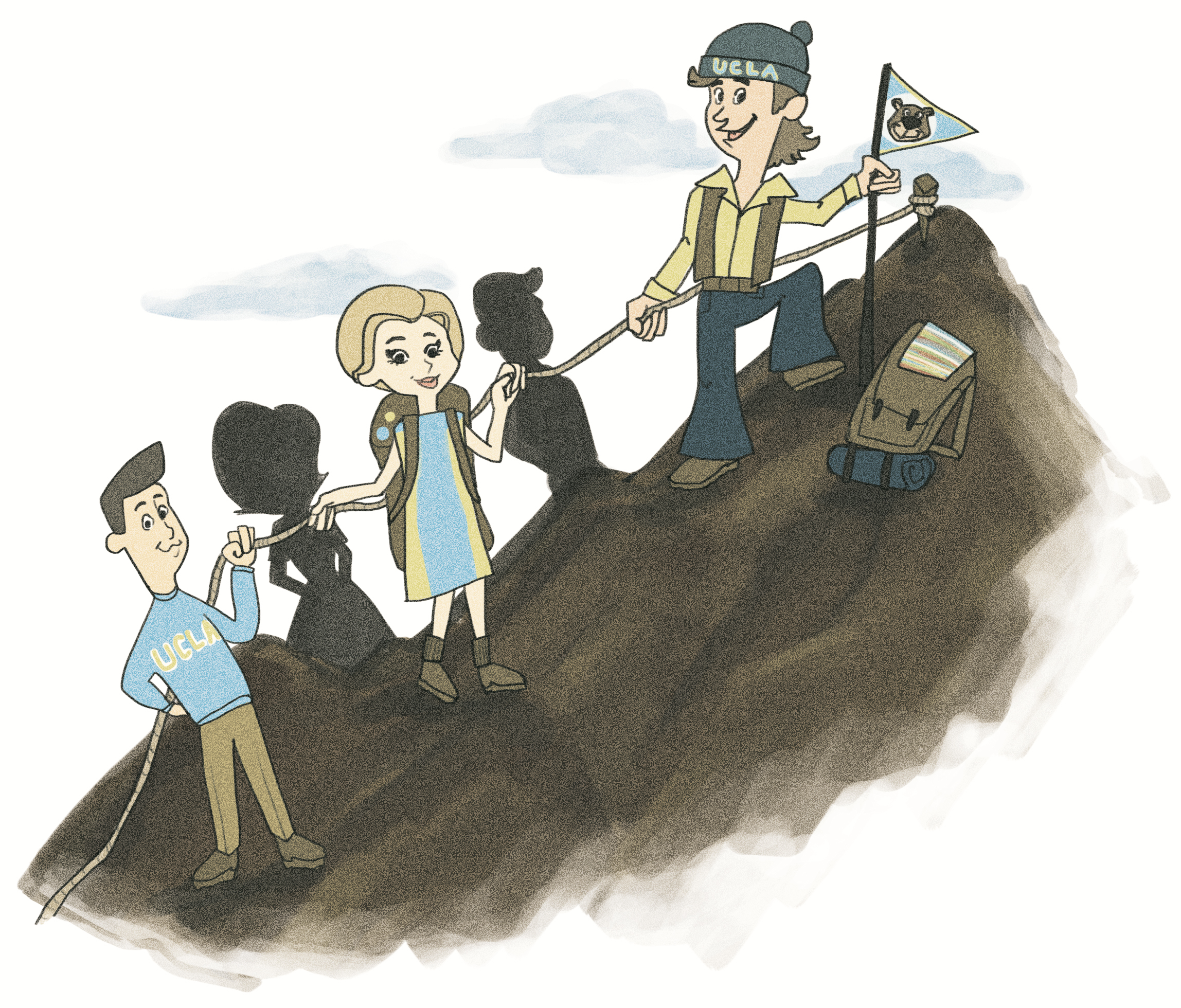The Trailblazers: Bruins help pioneer sport of mountaineering

Part One in a Series: Bruin Mountaineers
TODAYDecades ago, Bruin Mountaineers helped pioneer their sport.
THURSDAYA series of fortunate events brings a newcomer to the club.
On a foggy night in 1966, three friends camped on a narrow ledge protruding from the face of Half Dome, hundreds of feet above the ground. As the surrounding clouds parted, the climbers gazed with astonishment upon the moonlit landscape of Yosemite Valley.
Before turning in for the night, they pushed their small campfire off the ledge, watching it drift slowly to the ground before disappearing like a shooting star in the night sky. That fire was the last source of man-made light they saw on that trip. They were on their own, far above the surrounding landscape, upon a monument that few had ever conquered.
This story, one of the many adventures of former UCLA club the Bruin Mountaineers, was documented in the club’s newsletter, “Occasional Miseries.” The newsletter, published on and off throughout the club’s history, depicts the club’s progress as it pushed the boundaries of the up-and-coming sport of rock climbing.
”Back in those days, there weren’t a heck of a lot of guys who rock climbed … it wasn’t the phenomenon of mass participation that it is today,” said UCLA alumnus and former club member Bill Amborn.
Although precise dates of the club’s existence are unknown, the decades between the mid-1950s and the late 1960s saw these Bruins hike, climb and explore some of the most remote locations on the continent, including the High Sierra and places in Baja California, Arizona, Canada and Alaska.
Some locations were so isolated that there were no roads to drive or trails to follow. The mountaineers frequently undertook strenuous hikes through unmarked terrain just to get to their destination.
Being so far from any help meant that the Bruin Mountaineers had to rely on their equipment, training and most importantly, one another.
“If you screwed up badly, you were probably going to be in serious, serious trouble,” said Amborn.
Fortunately, the club was stacked with experienced climbers who provided guidance to their fellow Bruin Mountaineers.
Looking back on his time as a mountaineer in the mid-1950s, alumnus Dave Harvey said, “I climbed with men that did some of the most outstanding climbs in North America.”
Among these notable Bruin Mountaineers was Mike Sherrick, a member of the first group to successfully scale the sheer face of the Half Dome in 1957.
Such excellence in climbing requires extensive practice – something the Bruin Mountaineers got a lot of.
“Almost every Sunday we would go climb at Stoney Point near Chatsworth,” Amborn said. “That’s where you started learning the ropes.”
“We would climb until we could barely open our hands,” Harvey added.
The many weekends spent climbing together forged strong bonds, several members said.
“There is something special about climbing with somebody because you kind of depend on them,” Amborn said.
In the eyes of the members, this trust in each other made the Bruin Mountaineers much more than a casual social club.
“It got to be like our fraternity,” said Paul Cooley, former member of the club. “It was a study hall, lunch spot and a place for friends – yes, there were some marriages that came out of it, too.”
Members shared that the outdoorsy spirit that drew them to the sport made them unique from other student groups at that time.
“People in the climbing community tend to be … kind of interesting,” said Amborn. “They have a different view on life and death and courage”.
But Amborn said the value of the club went even beyond the bonds forged between members. He remembers traversing the face of a 1300-foot ledge while climbing the Lost Arrow Spire in Yosemite, where the view of the ground far below “made (his) stomach sick.”
“But it was my great realization that if I could just focus on doing what was important in front of me, then the height didn’t really matter,” said Amborn.
The experiences the club shared had formed bonds that have lasted until the present day, with members interacting frequently both on online climbing forums and in person. Although most of the members went on to do non-climbing related activities after college, they said the memories – and the lessons they offer – have never faded.
“It built my self-confidence,” Cooley said. “There is nothing like looking at a mountain from the bottom and then being on top and saying, ‘I did it’ – or better yet, ‘We did it’.”


